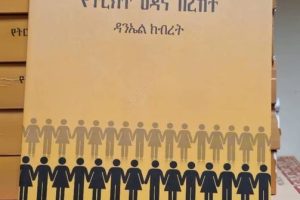
Various documents and biblical verses show that the celebration of Meskel, which is distinguished in various styles and practices across the regions of Ethiopia, could be traced back to the Holy Bible. The article written by Tsegaye Girma and Synodos Tesfay articulated the background and religious perspectives that led this celebration to be eagerly welcomed yearly in the following way.
Human beings were tempted by the words of the devil which targeted to discrete humans from their Creator. After the wrong deeds of humans that followed the direction of the devil’s spirit, there was a wall that was built to estrange the races of human beings from God. Thus, humans were forbidden to enter the gate to God’s Paradise. Then Jesus Christ, one of the three entities from the Holy Trinity, had come to human beings to expiate their sins and to do away with that wall. He arrived as a human being. Thus, he endured all the severe deeds to redeem us. He was crucified on the cross with the other two criminals who were accused of robbing and terrorism. Then on that cross, he mentioned human beings as ‘my sons’ which means he atoned for the sins of humans on that cross. The wall is ever broken. Life with Jesus Christ was confirmed. We got redeemed from our depravity through his death. Here is the evidence in the Bible, “But God forbids that I should glory, save in the cross of our Lord Jesus Christ, by whom the world is crucified unto me, and I unto the world.” (Gal 6:14).
Then according to the belief of Christians, he was resurrected. After his resurrection, the cross that he was crucified was making miracles among the believers. Then the Jews were not happy. Then they took it and buried it so that no one could find it. They made a point frequently throwing garbage on it. Through time it piled up to form a hilltop.
In 319 E.C Queen Elena was curious to look for the cross of Jesus. She then headed to Jerusalem. In the city, there were three hilltops. As the document found from the website of Mahbere Kidusan showed, she met with an old man called Kirakos. He directed her to three hilltops located in the city and told her to excavate them one by one because the true cross was buried in one of the three places.
The Queen summoned all the priests in that city for collective prayers. Then she set up a strategy. She ordered her maids to prepare wood and build a bonfire.
Deacon Girma Gelaye, who is a PhD candidate in the department of Philology at Addis Ababa University, told The Ethiopian Herald that it is believed that one of the priests lit the bonfire. The queen was simply ordering the steps and waiting with common women gatherings. In this fire, the priests added incense. Then the smoke dragged into the sky and bent down on the hill where the cross was buried. Following this smoke, she ordered the people to excavate the hill. Then the cross was found with other crosses. The real cross that Jesus was crucified was identified by its miraculous deeds.
According to sources, in the Middle age the patriarch of Alexandria in return for the protection of the Coptic Christians in Ethiopia, he gave some part of the true cross to Emperor Dawit. This cross is currently found in Gishen Mariam church found in the northwest of the country.
Thus, in the memory of that bonfire, the Orthodox Christians prepare a bonfire that tops the cross on its tip. Then it is decorated by daisies yellow flowers. Though the basic cultural orchestrations are the same, very unique and interesting practices across different regions are variedly done in this day.
For this article let me raise a cultural deed which is exhibited at Meskel.
In the northern part of the country particularly in Gojjam, there are eye-catching cultural; and religious practices observed. Among these achembila and engurogebash are the well-known traditional practices in the area. The equivalent meaning for these terms could be a grass-made bracelet and the alert of the transition to the New Year consecutively.
The researcher and instructor at Debre Markos University, Mintamir Lingerh had been examining the practices in her study. In the interview with The Ethiopian Herald she said the following.
The material that is used to make the grass bracelet is collected from the types of taller especial grasses called Giramta which are usually having their own motely colors. Then based on the preferences of the colors, the grass is modified in a way that could be made smooth for stylistically tiding the colors of the grass which is called Achembila. The size is made based on the thickness of the hand of the girls. That means it is girls who are supposed to wear this bracelet.
As Mintamir elaborated, this Achambila is made in the following steps. Three pieces of the modified grass lay on one hand. And another three pieces of another grass, which is separated from the former one by one thicker and stronger grass, is organized, thus, the cumulatively of the pieces mounted up seven. The implication according to the researcher is the three pieces symbolize the Holy Trinity and the strongest one symbolizes the Absolut oneness of the Trinity in appearance, spirit and role. The sum total that makes seven show the day devoted to Holy Trinity. Thus, in the name of one God the bracelet is made and put on since the seventh day of Meskerem till three days remain before the holyday. This bracelet is usually made by males. The implication is Jesus is the head of the church likewise males are the heads of the house. So, the belief is it invites the Holy Spirit and dispels the Satan spirit.
When the bonfire is mostly lit by the older men or any men, the bracelets or Achembila will be thrown into the fire. Then girls paint the ashes on their foreheads. The meaning is this ash is believed to cure people from any sin and cure the spiritual and body defections. The ground for this trust is the bonfire symbolizes the light to the true cross. Thus the fire of this wood is assumed as the powerful fire that can avoid any form of pain and depravity. As Mintamir confirmed this logic, it is parallel to the flesh and blood of Jesus Christ which is believed could redeem human beings since His bnlood poured out on the cross. Thus the ash which is poured after the light of the cross can also cure human beings from many threats.
In the early morning of Meskel celebration day, tied-up twigs called Chibo is lit by male elders or any male sections of the family. As Mintamir said it in the absence of a man in the family a woman who carried a baby boy could lit it. Then they hold the twigs and slightly burn the floor of the gate. The act symbolizes, as she mentioned it, cursing the envious, jealousies and any wrong doers. Then after these people did run to the kitchen and approach every material in the kitchen saying ‘Engurogobash’, the nearer meaning is happy transition to the New Year. After touching all basic utensils like the clay pot, Mitad (oven) which is used for baking Injera, jars by the tip of the bundle of burning twigs, they leave out to the nearby houses to do the same thing.
They utter Engurogobash to every individual at every household by carrying the burning. Since they did it getting nearer to people, as Mintamir noted in her talk, the approached people could shout out fearing the fire. This is done with the belief that the bad spirit which is believed there is a person is going to be scared and leave up that person when he or she shouts suddenly and it is also part of the fun in the day.
Though practices like Achambila and Engurogobash are dominantly exhibited in the area of Gojjam, the basic religious orchestrations like the bonfire and the tided wood or Chibo are inclusively practiced by other regions including the capital city, Addis Ababa. Meskel Square with the singing and dancing of religious melodies by the massive religious followers who gather in the place attired with cultural clothing. The ceremony is so an impressing and a unique one that it is registered as an intangible heritage at UNSECO.
Happy Meskel!
BY MEKDES TAYE (PhD)
THE ETHIOPIAN HERALD THURSDAY 26 SEPTEMBER 2024




